Latin name
Trachinotus carolinus
Other names
Portuguese: pampo, pampo-verdadeiro; Spanish: palometa, pampano, pampano-amarillo.
Identification
When alive, it has a silvery color, but it is one of the few fish whose color becomes brighter after death. It takes on a greenish-gray or dark blue hue on the back and a golden hue on the belly and fins. Deepwater or darker fish tend to have a golden hue on the throat, belly and anal fin. In young fish, the belly, anal fin, and tail are usually yellowish. The fish has a deep, flattened body, a short, blunt snout with a small mouth, and a deeply forked tail. The pompano has no spines on the caudal appendage. The first and dorsal fin is very low and typically poorly visible, while the second dorsal fin has a single spike and 22 to 27 soft dorsal rays. The anal fin, which starts slightly further back on the body than the second dorsal fin, has three spines and 20 to 23 soft anal rays.
Distribution
Occurs from Massachusetts to Brazil and throughout the Gulf of Mexico. They are most prominent from the Chesapeake Bay to Florida and west to Texas, and are abundant in the warm waters of Florida and the Caribbean.
Habitat
Inhabiting coastal and estuaries waters, adults are found along sandy beaches, including oyster bars, grass beds, and bays, and often in the muddy water of brackish bays and estuaries. They usually prefer shallow water, but can be found in depths of up to 130 feet. Normally forms small or large flocks that move close to shore and migrate north and south along the Atlantic coast, remaining in waters of 82° to 89 °F.
Size
Its life span is about 3 to 4 years. It rarely grows more than 6 pounds and 25 inches in length, and usually weighs less than 3 pounds. The world record for all tackle fishing is an 8 pound, 1 ounce Florida fish.
Life history and Behavior
Reaching sexual maturity at the end of the first year of life, Floridian pompano spawn in the sea from March to September, with peak activity from April to June.
Food and feeding habits
Питается моллюсками, ракообразными и другими беспозвоночными, а также мелкой рыбой.
Reproduction
No information
| Classification | |
| Phylum | Chordata |
| Class | Actinopterygii |
| Squad | Carangiformes |
| Family | Carangidae |
| Genus | Trachinotus |
| Species | T. carolinus |
| Features | |
| Conservation status | Least Concern |
| Habitat | Pelagic |
| Life span, years | 7 |
| Maximum body weight, kg | 4.1 |
| Maximum length, cm | 66 |
| Sailing speed, m/s | No information |
| Threat to people | Edible |
| Way of eating | Bentophage |


